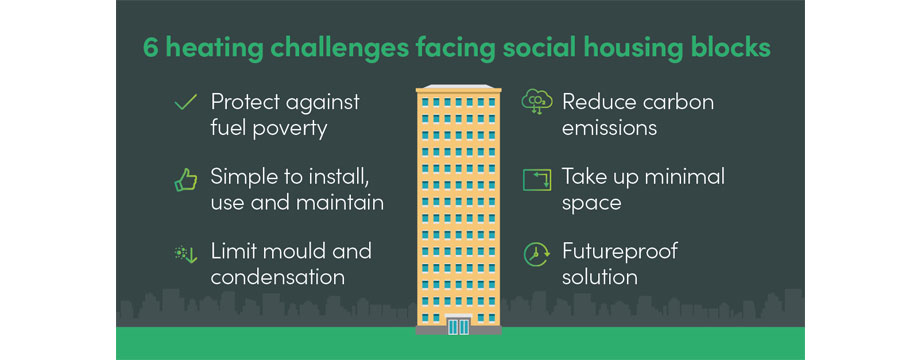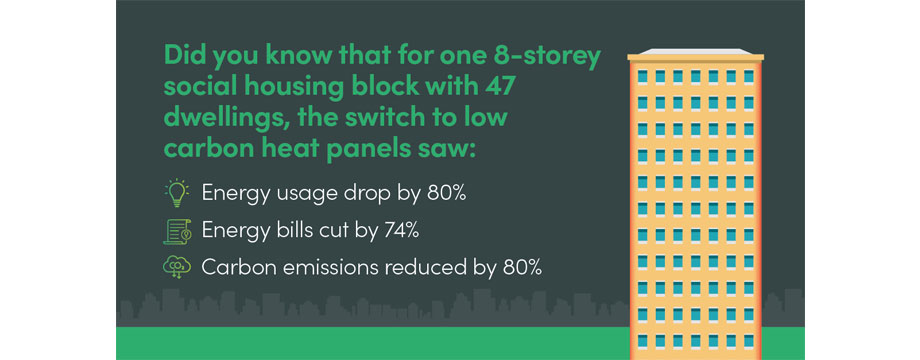The majority of Britain’s tower blocks have originally been designed to provide affordable and safe housing to a large number of residents. With great views and surrounding public open spaces, many of them were created to replace damaged or unsanitary pre-war dwellings, with the aim of modernising our cities and improving the living conditions of many.
However, despite the designers original intentions, tower blocks are now notorious for high energy bills. This is due to the fact that most of these high-rise, multi-occupancy buildings use electric storage heaters that are expensive to run and don’t provide adequate temperature control. This challenge is especially serious in the case of social housing blocks, where residents are particularly vulnerable to fuel poverty.

At the same time, the age and design flaws of many tower blocks can lead to issues with damp, mould and condensation, which can cause or aggravate respiratory problems such as asthma and allergies.
Yet, with proper renovation and an adequate heating system, tower blocks can provide good-quality housing for millions of people, while helping the UK cut the carbon emissions caused by inefficient home heating.
Meeting the 2050 net zero challenge
Together with reducing energy bills and providing sanitary accommodation, decarbonising tower blocks is a key strategic challenge for local authorities, housing associations and property owners.
To meet the UK’s legally binding target of achieving net zero by 2050, whatever heating solution is chosen to replace electric storage heaters needs to be built for the future, radically reducing carbon emissions and the associated impact on the environment. Even for high-rise buildings operating on gas, many are considering how they can switch to a safer, more sustainable alternative.
While many properties are turning to heat pumps, this technology is often unsuitable for smaller homes and multi-occupancy buildings. With a high upfront cost and a lengthy, complicated and often disruptive installation process, these systems require space that is often not available in properties of this size. Requiring pipework, radiators and external condenser units, heat pumps can also be costly to service and maintain.
In fact, the warm air they produce, when coming in contact with cold walls, can cause further mould and condensation and harm residents’ wellbeing.

A low carbon solution
With traditional systems failing to ensure the whole home is adequately and efficiently heated, and options like heat pumps considered unsuitable or impractical for tower blocks, many housing providers are turning to low carbon heat panels.
Ambion Low Carbon Heat Panels offer a high-performance, low carbon source of heat that allows residents to drastically reduce their energy bills, while enjoying a natural warm feeling and improved air quality.
Performance is achieved with Ambion’s unique control system, which uses constant dynamic pulsing to dramatically reduce energy usage and maintain a room’s temperature within 0.1˚C of its target, 24 hours a day. Building materials absorb and store the infrared emitted from the low-carbon heat panels, and release this heat when the system is pulsed off to keep the room at its desired temperature. With data collected every hour, energy usage and spend can be easily monitored at all times.
Crucially, the panels heat the fabric of a room, rather than the air. Building materials absorb and store the infrared emitted from the heat panels, releasing this heat when the system is pulsed off to keep the room at its desired temperature. The entire system can be controlled by a single, intuitive control panel, so tenants can enjoy an easy-to-use heating system with confidence.
Oliver Baker, CEO of Ambion, a leading provider of low carbon infrared heat panels, explains: “ Because the panels heat the fabric of a room, rather than the air, they significantly reduce condensation and mould which can be a major problem with tower blocks.”
Oliver adds: “Living in a warm and safe environment is critical to our health and wellbeing. Britain’s tower blocks often get bad press, but there’s an incredible opportunity to intelligently renovate this housing stock and extend the life of these buildings as warm, comfortable and low carbon homes.”
Low carbon infrared heating panels are ideal for tower blocks, as they overcome all the challenges of traditional convection systems, as well as the safety and environmental concerns of gas heating. Moreover, their sleek, space-saving design makes them perfect for smaller living spaces, where there is no room for a central boiler or heat pump unit.

Low carbon and low cost
As the name suggests, low carbon heat panels are in line with the UK’s decarbonisation goals. They are fully future-proofed to partner with solar and battery solutions, as well as time-of-use tariffs.
They have proven to cut carbon emissions by up to 80 per cent in flats when compared with conventional heating systems. Moreover, running costs are slashed by 80% in these properties when compared to traditional heating systems, ensuring housing providers are playing their part in reducing carbon emissions, while safeguarding residents from fuel poverty.
The quick, easy and hassle-free installation of low carbon heat panels ensures that residents experience minimal disruption, as no pipework or radiators are needed. They can be installed by any qualified electrician, and the cost of installation is half that of a heat pump.
Additionally, these panels have no moving parts, which minimises the risk of breakage and ensures that no maintenance will be required. In fact, they have an impressive 33 years of average active lifespan, as opposed to 10 years for traditional convection systems. For further peace of mind, low carbon heat panels come with a minimum 10-year guarantee.
Oliver continued: “Ambion is on a mission to create happy, healthy homes, with many housing providers already reaping the rewards of choosing low carbon heat panels. In an 8-storey social housing block from 1956, which contains 47 dwellings, the switch to Ambion’s solution saw energy usage drop by 80 per cent, energy costs fall by 74 per cent, and carbon emissions cut by 80 per cent.”
Tower blocks may pose unique heating challenges, but with adequate renovation and forward-looking technology, they can be future-proofed and converted into the affordable, sustainable and safe housing they were originally designed to be.
Get in touch to find out more about the benefits of low carbon heat panels for tower blocks and other high-rise buildings.
www.ambionheating.com
sales@ambionheating.com
0333 188 0633
- Log in to post comments













